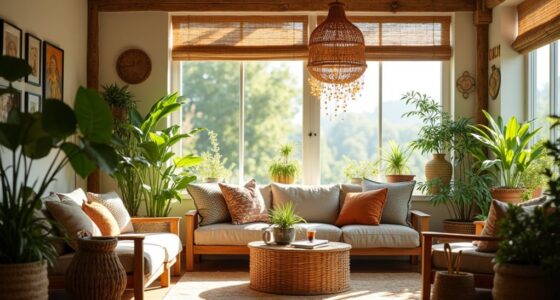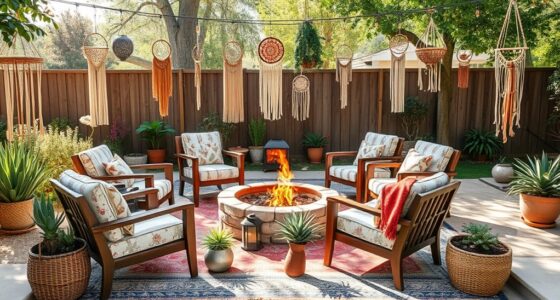For your boho home, use sustainable materials like reclaimed wood, bamboo, and organic textiles to add character and eco-friendliness. Incorporate eco-friendly finishes with natural paints and low-VOC sealants, and choose fixtures like LED lighting and recycled hardware. Upcycle vintage items into unique decor or furniture and bring in plants with biodegradable planters to boost air quality. Embracing these ideas helps create a stylish space that’s kinder to the environment—get inspired to make a difference.
Key Takeaways
- Utilize reclaimed wood, bamboo, and recycled materials for flooring, furniture, and decor to reduce waste and promote sustainability.
- Apply non-toxic, natural finishes and earthy tones to enhance natural textures and support healthy indoor air quality.
- Incorporate energy-efficient lighting like LED and vintage Edison bulbs, paired with eco-friendly fixtures and hardware.
- Repurpose vintage items and pallets into unique furniture pieces to minimize waste and add character.
- Integrate indoor plants in biodegradable planters to improve air quality and introduce biophilic design elements.

If you’re looking to update your home while minimizing your environmental impact, eco-friendly renovation ideas offer a smart and sustainable approach. When aiming to create a boho-inspired space, you can focus on incorporating sustainable materials and low impact finishes that align with your aesthetic and values. Using sustainable materials means choosing products that are renewable, recycled, or have a low environmental footprint. Think reclaimed wood for flooring or furniture, organic cotton textiles, and bamboo for cabinetry or decorative elements. These choices not only add character and warmth to your space but also reduce your carbon footprint.
Incorporate sustainable materials like reclaimed wood, organic textiles, and bamboo to create a warm, eco-friendly boho space.
Incorporating low impact finishes is equally important. Opt for natural, non-toxic paints and stains that emit fewer volatile organic compounds (VOCs). These finishes are healthier for you and the environment, and they help maintain your indoor air quality. For a boho vibe, look for earthy shades and textured finishes that highlight the natural beauty of the materials you select. You might also choose eco-friendly sealants or waxes that provide a protective layer without harmful chemicals, enhancing your space’s authenticity and sustainability.
Your choice of fixtures and hardware can also reflect eco-consciousness. Select energy-efficient light fixtures, such as LED bulbs or vintage-inspired Edison bulbs, which add a nostalgic charm without wasting energy. When it comes to furniture, prioritize pieces made from recycled or sustainably sourced materials. Handcrafted items from local artisans support community economies and minimize transportation emissions, aligning perfectly with the boho ethos of individuality and eco-awareness.
Another way to embrace eco-friendly renovations is by repurposing or upcycling items. For example, transform vintage suitcases into side tables or repurpose pallets into coffee tables. This not only reduces waste but also infuses your space with a sense of history and uniqueness. Additionally, integrating plants into your design enhances the boho aesthetic while improving air quality and creating a calming environment. Use biodegradable planters and natural fibers for your hanging or potted greenery to stay consistent with your eco-friendly goals.
Furthermore, considering the use of sustainable building practices such as passive solar design can help optimize energy efficiency and reduce your overall environmental impact.
Frequently Asked Questions
How Can I Reduce Water Usage During Renovation?
You can reduce water usage during renovation by installing low-flow fixtures like faucets and showerheads, which cut water consumption without sacrificing functionality. Consider adding rainwater harvesting systems to collect and reuse water for gardening or toilet flushing. Additionally, check for leaks regularly and upgrade old plumbing to guarantee efficient water use. These steps help you conserve water and make your boho home more eco-friendly.
What Sustainable Materials Are Best for Boho Decor?
For boho decor, you should choose sustainable materials like reclaimed wood and organic textiles. Reclaimed wood adds rustic charm while reducing waste, and organic textiles, such as cotton or hemp, are eco-friendly choices that bring natural textures into your space. These materials not only support sustainability but also enhance the boho aesthetic with their warm, earthy tones and relaxed vibe. Incorporate them into furniture, decor accents, or textiles for a conscious, stylish home.
Are There Eco-Friendly Ways to Insulate My Home?
Yes, you can insulate your home eco-friendly by recycling old materials and choosing natural insulators. Imagine giving new life to items like denim or wool, turning waste into warmth. Natural options like cellulose, sheep’s wool, or cork trap heat effectively without harming the environment. By doing so, you not only save energy but also embrace sustainability, making your boho space cozy and eco-conscious at the same time.
How Can I Incorporate Renewable Energy Into My Renovation?
You can incorporate renewable energy into your renovation by installing solar panels to harness sunlight and generate electricity. Consider adding small wind turbines if your location has consistent wind, providing additional power. These options reduce reliance on fossil fuels and lower your carbon footprint. Make sure to choose eco-friendly, efficient systems that blend seamlessly with your boho style, creating a sustainable, stylish home that’s both functional and eco-conscious.
What Are Affordable Eco-Friendly Renovation Options?
You can save money and go green by installing affordable solar panels, which reduce your energy bills and carbon footprint. Consider setting up composting systems to manage waste sustainably and enrich your garden naturally. Use recycled or reclaimed materials for furniture and decor to minimize environmental impact. These options are budget-friendly, practical, and enhance your boho home’s eco-conscious vibe while keeping costs low.
Conclusion
By embracing eco-friendly renovations, you can create a stylish, sustainable boho home that reflects your values. Imagine transforming a worn-out space into a vibrant sanctuary using reclaimed wood and low-VOC paints; for example, a homeowner in Portland did just that, reducing their carbon footprint while adding unique character. With small changes like these, you’ll enjoy a beautiful home that’s good for the planet—and perfect for expressing your free-spirited boho style.









